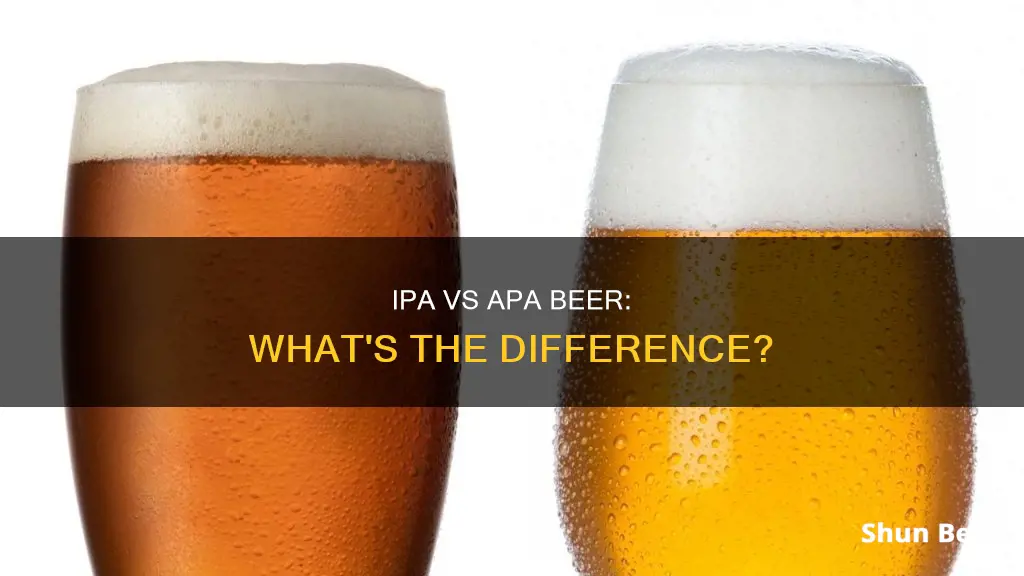
APA stands for American Pale Ale, while IPA is short for India Pale Ale. Both are top-fermented beers (ales) and are generally light in colour. However, the main difference lies in their geographic origins, flavour profiles and alcohol content. APAs, originating from the US, are known for their prominent use of American hops, resulting in a well-balanced beer with a lighter character and a citrusy punch. IPAs, on the other hand, were originally brewed in England and tend to be hop-and-alcohol-heavy, making them more suitable for long journeys and preservation.
What You'll Learn

IPAs are hop-and-alcohol-heavy, APAs are more balanced
The main difference between IPAs and APAs is that IPAs are hop-and-alcohol-heavy, while APAs are more balanced.
IPAs, or India Pale Ales, originated in England in the 18th century. They were brewed with a large number of hops to ensure that the beer did not spoil during long voyages from England to India. IPAs tend to be alcohol-heavy and have a strong presence of malts with biscuity flavours. The hops used in traditional British IPAs deliver herbal and blackcurrant notes, while American IPAs tend to feature the brash citrus and pine characters of native hops.
On the other hand, APAs or American Pale Ales, originated in the United States around 1980. APAs are characterised by a balance between malt and hops, with the hops being more assertively pungent and floral than their British counterparts. APAs typically have a moderate alcohol content, ranging from 4.5% to 6% ABV, and are easy to drink.
While IPAs are known for their strong hoppy flavours and high alcohol content, APAs offer a more balanced drinking experience, with the malt and hops working together in harmony.
However, it is important to note that the lines between these two styles of beer can sometimes blur, and brewers may experiment with different ingredients and techniques to create unique interpretations of these classic styles.
Beer Strength Differences: 3.2 vs. 6 ABVs
You may want to see also

IPAs were originally created to survive long shipping times
India pale ale (IPA) is a hoppy beer style within the broader category of pale ales. The name comes from the beer's creation in the 18th century as an export beer shipped to India, which was under the control of the British East India Company until 1858.
The pale ales of the early 18th century were lightly hopped and quite different from today's pale ales. By the mid-18th century, due to the development of coke, a clean-burning form of coal, maltsters were able to produce a lighter-coloured malt than the charred, dark, smoky version that was typical of beer before 1700. This new malt was less charred and smoky, resulting in a lighter-coloured beer.
One such variety of beer was October beer, a pale and well-hopped brew popular among the landed gentry, who brewed it domestically. Once brewed, October beer was intended to be cellared for two years.
Among the first brewers known to export beer to India was George Hodgson's Bow Brewery, on the Middlesex-Essex boundary. Its beers became popular among East India Company traders' provisions in the late 18th century due to the brewery's proximity to the East India Docks and Hodgson's liberal credit line of 18 months. Ships exported this beer to India, among them his October beer, which benefited exceptionally from the conditions of the voyage and was highly regarded by its consumers in India.
Burton breweries, which had lost their export market in Continental Europe due to the Napoleonic blockade, sought a new export market for their beer. At the behest of the East India Company, Allsopp's brewery's chief maltser, Job Goodhead, developed a strongly-hopped pale ale in the style of Hodgson's for export to India. Other Burton brewers, including Bass and Salt and Co, followed Allsopp's lead, taking advantage of Burton water in brewing similar beers.
Early IPAs were only slightly higher in alcohol than other beers brewed at the time, but more of the wort was fermented, meaning fewer residual sugars, and they were heavily hopped. While IPAs were formulated to survive long voyages by sea better than other styles of the time, porter was also successfully shipped to India and California.
By the 1860s, India pale ales were widely brewed in England, and they were much more attenuated and hopped than porters and ales. Demand for the export style of pale ale, which had become known as "India pale ale", developed in England around 1840 and India pale ale became a popular product in England.
While the creation of IPAs was indeed motivated by the need to survive long shipping times, the idea that beer could not survive the voyage to India without spoilage is not entirely true. Ale and beer were being successfully exported to India and farther from at least the beginning of the 18th century, and while there was some spoilage, shipments of beer could easily last a year or more in cask.
Porter, a dark beer, also continued to be popular in India throughout the 19th century, and strong dark beers are still drunk in hot climates today, from Sri Lanka to the West Indies.
IPAs were formulated to survive long shipping times better than other beers, and they succeeded in this regard. However, the notion that they were invented solely to address the issue of spoilage during long voyages is not entirely accurate. The development of IPAs was influenced by various factors, including the loss of export markets for Burton breweries due to the Napoleonic blockade and the desire to capitalise on the growing demand for beer in India.
Beer Classification: 3.2 vs 5.0 ABV Difference Explained
You may want to see also

APAs have a lighter character and citrusy notes
The American Pale Ale (APA) is a style of pale ale that is generally around 5% ABV. It is characterised by a balance of malt and hops, with the hops being more pungent and floral than those in British or European pale ales. APAs have a lighter character and citrusy notes, with fruity and diacetyl flavours ranging from zero to medium, and hops ranging from light floral aromas to intense spicy aromas.
The first historical examples of APAs had very intense colours, ranging from deep gold to pale amber, which surprised consumers who were used to the straw-yellow colour of industrial lagers. The answer to this discrepancy lies in the connection to the old British brewing tradition, where "pale" essentially meant "not dark". In past centuries, all beers were darker than they are now, as malts were dried using a direct flame.
Today, APAs are easy to drink and have a light body and a moderate alcohol content. The hops grown on the American Pacific coast take centre stage, without being excessively pungent in the bouquet or bitter in the finish. At the beginning of the craft movement, the most commonly used hop varieties typically gave citrusy notes, reminiscent of tangerines, grapefruit zest and bergamot. Now, brewers tend to prefer hops with warm and tropical scents such as passion fruit, mango, pineapple, lychee, and guava.
The difference between APA and IPA is on a sliding scale. An APA at around 5% ABV is very well balanced between malt and hops. In an IPA, the malt is more subdued, allowing the hops to shine. A good way to understand the difference is to taste Panhead's Supercharger APA and Epic's Pale Ale side by side. The latter has a big caramel malt base and traditional American Cascade hops with notes of citrus and Turkish delight, while the former is slightly leaner on the malt with Simcoe, Citra and Centennial hops, which tend towards stone fruit flavours such as peach and lychee.
Beer Nuts vs Deer: What's the Difference?
You may want to see also

British IPAs are malty, American IPAs have a cleaner malt base
When it comes to the maltiness of IPAs, there is a clear difference between British and American varieties. British IPAs tend to be maltier, even buttery, with fruity esters and a hop character that delivers herbal and blackcurrant notes. In contrast, American IPAs have a cleaner, leaner malt base, allowing the brash citrus and pine characters of native hops to create a more hop-forward drinking experience.
The malt character of British IPAs comes from the use of British pale ale malt, which imparts a "biscuity" flavour. They also often have a higher ABV and are hoppier than English bitter beers. English IPAs also showcase classic English hops such as Kent Goldings, which further emphasises their maltiness.
On the other hand, American IPAs are known for their assertive pungency and floral notes, which come from the use of American hops. They are usually stronger and hoppier than their British counterparts, with a lighter colour and malt profile. American IPAs also tend to be better attenuated, resulting in a drier finish.
The difference in malt character between British and American IPAs is not just a matter of preference but also has a historical context. IPAs were originally created as a strong pale ale with extra hops to preserve the beer during its long journey from England to British troops in India. Over time, the style evolved, and in the 1980s, American craft brewers began brewing their own versions using American hops, thus creating the distinct American IPA we know today.
Exploring Diverse Beer Markets: A Global Perspective
You may want to see also

APAs are typically around 5% ABV
APAs, or American Pale Ales, typically have an ABV of around 5%. This places them in the "light to moderate alcohol content" category, making them an easy-drinking option for beer lovers. They are known for balancing malt and hops, with the hops taking centre stage and delivering a distinctive, yet not overwhelming, bitterness.
The ABV of a beer is a key factor in determining its style and characteristics. With an ABV of around 5%, APAs are considered a more sessionable option compared to their stronger counterparts. This means they are well-suited for social gatherings, casual drinking, and enjoying throughout the day without overwhelming the drinker.
The ABV also influences the flavour profile and overall drinking experience. At 5% ABV, APAs strike a delicate balance between maltiness and hoppiness. The malt provides a solid foundation, while the hops shine through with their unique characteristics. This balance makes APAs accessible to a wide range of drinkers, from those who prefer a malt-forward beer to those who seek out the bitterness and aroma of hops.
It is worth noting that while 5% ABV is a common range for APAs, there can be some variation among different brews. Some APAs may have a slightly lower ABV, closer to 4.5%, while others might push the boundaries and reach 6% ABV or slightly higher. These variations can be attributed to different brewing techniques, ingredients, and interpretations of the style by craft brewers.
In comparison to other beer styles, the 5% ABV of APAs positions them as a middle ground option. They are stronger than lighter beers like lagers, which often have an ABV of 4% to 5%, but more sessionable than heavier styles like double IPAs, which can reach ABVs of 8% and above. This moderate ABV allows APAs to showcase their complex flavours and aromas without overwhelming the palate.
In conclusion, the typical ABV of APAs at around 5% plays a crucial role in defining their character. It makes them versatile, approachable, and a popular choice among craft beer enthusiasts. This ABV range strikes a harmonious balance between malt and hops, creating a drinking experience that is both flavourful and refreshing.
Explore the Differences: Ale, Bitter, and Beer
You may want to see also
Frequently asked questions
IPAs (India Pale Ales) were originally made with a large number of hops to ensure that the beer did not spoil during long voyages from England to India. On the other hand, APAs (American Pale Ales) were developed in the United States around 1980 and are characterised by the use of American hops.
IPAs are hop-and-alcohol-heavy, while APAs have a balance of malts and hops, with a lighter character and a citrusy punch. APAs are also known for their strong regional character and can range from zero to medium fruity and creamy flavours.
English IPAs are maltier and have a more restrained hop character, delivering herbal and blackcurrant notes. American IPAs, on the other hand, have a cleaner, leaner malt base and use native hops to create a more hop-forward drinking experience with brash citrus and pine characters.
IPAs tend to be stronger and more assertively hopped than APAs. APAs generally have an alcohol content of around 5% ABV, while IPAs can be higher, such as 6% ABV or more.







